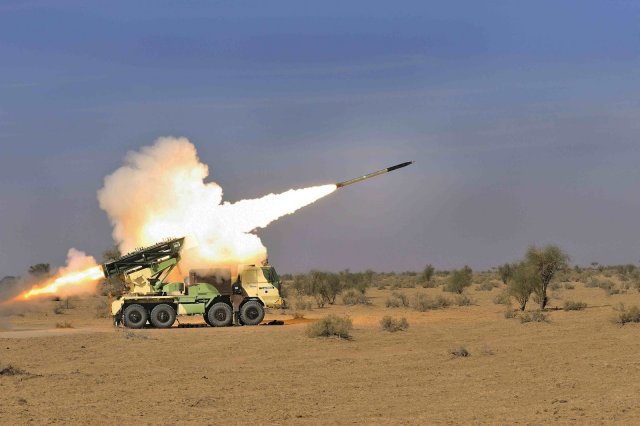|
|
|||
|
Defence & Security News - India
|
|||
|
|
|||
| Submunition Warheads Successfully Tested for Indian MRLS Pinaka I | |||
|
The advanced trials of Pinaka I, a multiple rocket launcher (MRLS) system, were successfully carried out for the 'submunition warheads' here at Pokhran field firing range in Rajasthan on Monday, June 29. Pinaka has been indigenously developed by the Armament Research and Development Establishment (ARDE), Pune, a laboratory of Defence Research and Development Organisation (DRDO) of the Indian Defence minister.
|
|||
|
|
|||
 Pinaka is a multiple rocket launcher produced and developed by the DRDO for the Indian Army Pinaka is a multiple rocket launcher produced and developed by the DRDO for the Indian Army |
|||
|
|
|||
|
Dr KM Rajan, director, ARDE, said that the success of the latest trials has paved the way for these submunition warheads to be used in mark-II version of Pinaka as well which is going to have a 20-km longer range. Claiming that the development trials for a 60-km range for Pinaka II have been termed successful by the users (Indian Army), Dr Rajan said that the current trials are a part of the 'proof trials' for the 'production lot of Pinaka I' wherein random Pinakas are picked up to test the performance standards of a specific lot at regular periods. "Complete systems, subsystems and efficiency for these submunition warheads have been tested today," said he. Senior DRDO officials said on the condition of anonymity that while Pinaka II has been tested for ranges beyond 60 kilometres as well, the DRDO is just claiming '60-kilometre-range' both for consistency and 'playing it safe' reasons. The DRDO officials disclosed that not only the volume of Pinaka rockets is being increased in the production lines to cater to the army's needs, even their strike capability in terms of a longer range is being increased. The indigenous Pinaka MBRL can act as a force-multiplier. It is known as an area weapon system which can fire a salvo of 12 high explosive (HE) rockets in 44 seconds while neutralising a marked area of 3.9 square kilometres. "We have seen Pinaka's performance during the Kargil episode. And now this thermo-baric ammunition is able to operate from a mobile launcher at extreme temperature ranges of -10 degrees Celsius to 55 degrees Celsius with a quicker reaction time. It also has the capability to carry various kinds of warheads. It has now become more lethal," said the official, adding that its thermal and blast effects have been developed for MBT Arjun to further boost its firepower. The state-of-the-art Pinaka MBRL system is endowed with a capacity to fire in different directions and can work in various modes including autonomous mode while being controlled by a fire control computer, standalone mode, manual mode or remote mode etc. Taking pride in the low-cost factor of Pinaka vis-a-vis other such rocket systems in the world bestowed with shoot and scoot capabilities, DRDO officials disclosed that a Pinaka battery consists of six launchers and each is equipped with 12 rockets. It can carry more than 100 kg of payload for a 40 km range as in case of Pinaka I. The Pinaka went into development in 1986 and production in 1998. The system mounted on a Tatra truck works in a way that all the 72 rockets in a single battery can be fired in just 44 seconds while each of the six launchers can fire in different directions too. The submunition warheads tested on Monday are among the eight kinds of warheads for Pinaka. The submunition incendiary warheads are valuable for inflammable targets while there are cluster warheads armed with anti-personnel and anti-tank submunitions. Runway denial penetrating submunition warheads are aimed at neutralising targets like runways and other complexes.
|
|||
Submunition Warheads Successfully Tested for Indian MRLS Pinaka I 30107155
- Posted On














